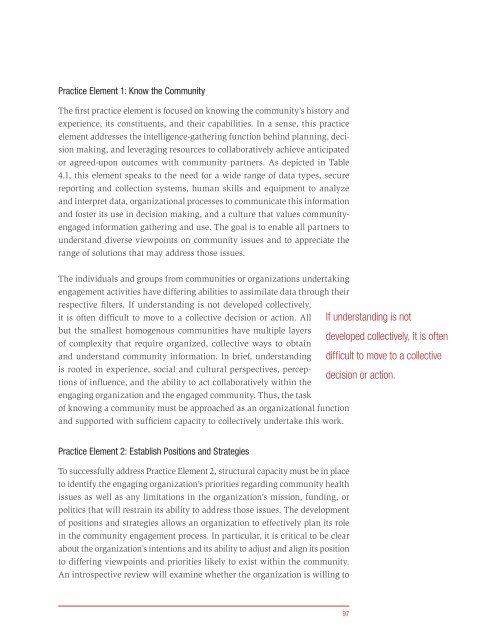Principles of Community Engagement (Second Edition)
Principles of Community Engagement (Second Edition)
Principles of Community Engagement (Second Edition)
Create successful ePaper yourself
Turn your PDF publications into a flip-book with our unique Google optimized e-Paper software.
Practice Element 1: Know the <strong>Community</strong><br />
The first practice element is focused on knowing the community’s history and<br />
experience, its constituents, and their capabilities. In a sense, this practice<br />
element addresses the intelligence-gathering function behind planning, decision<br />
making, and leveraging resources to collaboratively achieve anticipated<br />
or agreed-upon outcomes with community partners. As depicted in Table<br />
4.1, this element speaks to the need for a wide range <strong>of</strong> data types, secure<br />
reporting and collection systems, human skills and equipment to analyze<br />
and interpret data, organizational processes to communicate this information<br />
and foster its use in decision making, and a culture that values communityengaged<br />
information gathering and use. The goal is to enable all partners to<br />
understand diverse viewpoints on community issues and to appreciate the<br />
range <strong>of</strong> solutions that may address those issues.<br />
The individuals and groups from communities or organizations undertaking<br />
engagement activities have differing abilities to assimilate data through their<br />
respective filters. If understanding is not developed collectively,<br />
it is <strong>of</strong>ten difficult to move to a collective decision or action. All<br />
but the smallest homogenous communities have multiple layers<br />
<strong>of</strong> complexity that require organized, collective ways to obtain<br />
and understand community information. In brief, understanding<br />
is rooted in experience, social and cultural perspectives, perceptions<br />
<strong>of</strong> influence, and the ability to act collaboratively within the<br />
engaging organization and the engaged community. Thus, the task<br />
<strong>of</strong> knowing a community must be approached as an organizational function<br />
and supported with sufficient capacity to collectively undertake this work.<br />
Practice Element 2: Establish Positions and Strategies<br />
To successfully address Practice Element 2, structural capacity must be in place<br />
to identify the engaging organization’s priorities regarding community health<br />
issues as well as any limitations in the organization’s mission, funding, or<br />
politics that will restrain its ability to address those issues. The development<br />
<strong>of</strong> positions and strategies allows an organization to effectively plan its role<br />
in the community engagement process. In particular, it is critical to be clear<br />
about the organization’s intentions and its ability to adjust and align its position<br />
to differing viewpoints and priorities likely to exist within the community.<br />
An introspective review will examine whether the organization is willing to<br />
If understanding is not<br />
developed collectively, it is <strong>of</strong>ten<br />
difficult to move to a collective<br />
decision or action.<br />
97

















